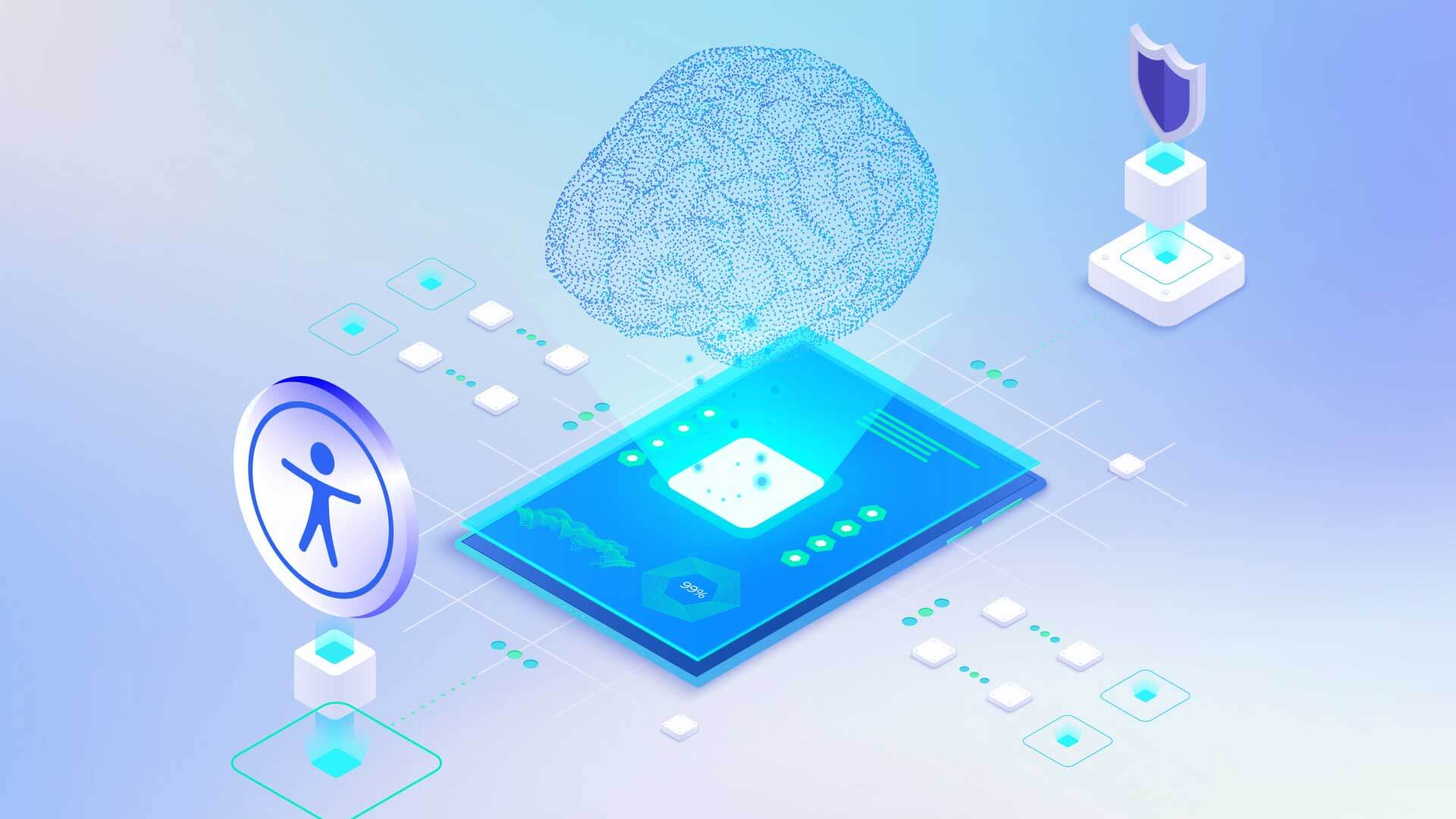How AI and Accessibility Transform Digital Experiences

Humanity is increasingly looking for innovative ways to empower individuals with disabilities with technology that improves quality of life. Artificial Intelligence has become a turnkey resource to drive inclusion and support the developing demands, obligations, and social responsibilities of organizations to create barrier-free digital experiences. AI and accessibility solutions fueled by robust deep and machine learning algorithms have taken user experience (UX) to the next level.
The power of artificial intelligence technologies and accessibility solutions to enhance online experiences is not exclusive to people with disabilities. Individuals of varying abilities and diverse backgrounds have adopted solutions with AI and accessibility to go about their daily lives. AI for accessibility of digital spaces supports all individuals with challenges speaking, typing, writing, memory, pointing, sight, hearing, cognition, mobility, and more.
In this blog post, we’ll look at how AI and accessibility solutions make it happen.
We’ll investigate how AI is integrated into our daily routines, online interactions, and across different industries. We’ll also look at how A-powered solutions embrace the diversity of every online user to make digital experiences frictionless and free of barriers.
How can artificial intelligence technologies improve accessibility?
Artificial intelligence technologies can greatly enhance accessibility by automating tasks, providing real-time assistance, and adapting interfaces based on individual needs. From speech recognition for those with motor disabilities to text-to-speech capabilities for the visually impaired, AI offers a spectrum of tools.
AI-powered solutions can also boost accessibility in many aspects of everyday life .For example, it can simulate human capabilities, used to perform digitally automated tasks – time-consuming, tedious, and even prone to human error. But on a social empathy level, it not only creates inclusive digital experiences, it simplifies, enhances and amplifies UX for everyone.
Our smartphones integrate a range of tools to create equal grounds in the digital playing field with generative AI. From voice, facial, and fingerprint recognition, to voice to text technology, automated color contrast, screen brightness, and adaptive zoom in and out. All of these inclusive AI-powered options and tools optimize mobile and desktop digital accessibility.
These innovations not only bridge accessibility gaps but also empower individuals to lead more independent and fulfilling lives. That’s where assistive AI intervenes and becomes the technological shoulder to lean on for people with disabilities.
What is the role of AI as an assistive technology?
Imagine having uncontrollable shaky hands from panic disorder, Multiple Sclerosis spasms that limit mouse navigation or gripping a smartphone, or vision impairments that limit engagement with images, videos, or infographics. What seems like an inherently simple drag and drop or tap of the screen, or merely a breezy task like picking up a device, or seeing the graphics and understanding the value of visuals – all become a challenge. That is, if the experiences and devices are not designed in a way that’s accessible.
So, why not take the AI initiative so many businesses are in fact taking: design and develop your digital devices and spaces with inclusion at heart.
Let’s look at some of the innovations that have made digital inclusion possible with AI intelligence, and truly embrace the importance assistive intelligence has in our daily lives.
How does biometric identification boost digital accessibility?
Straight to the point, cybersecurity and identity theft are common and real issues in our digitally driven society. Data, especially sensitive information like birth dates, credit cards, and information about our medical conditions are often sought out by hackers to be sold on the dark web. They can be used to hack systems or even hold businesses ransom for millions, billions and trillions of dollars. Worse yet, the sensitive data of countless users can be exposed.
Fast forward to the 21st century of AI for accessibility, and forget messy passwords, entering in codes, personal data, and sensitive information to log in to systems. Now, your face, fingerprint, and voice can not only keep your data more secure, but can actually be used with unique biometrics applications and platforms to log in. So details of your personal or professional lives stay stored inside platforms. Without your face, fingerprint or voice access is denied.
But biometrics can also make it easier for people with disabilities to access online experiences. Here’s how.
Instead of typing in a username, password, birthdate, and personal info that malicious actors could be seeking on networks, let the power of assistive AI scan your face, fingerprint and hear your voice to grant you access. For someone using a screen reader, voice recognition goes hand in hand, as often these are individuals with visual disabilities. For a user engaging with a website who has Parkinson’s Disease, they may tremble and experience difficulties typing, holding a device, or tapping a screen.
The power of AI gives these individuals the free will to choose how their unique face, fingerprint, or voice open the doors to digital spaces. And of course, the added bonus of reinforcing security can’t hurt in today’s tumultuous cyberspace, with security threats and breaches making headlines by the minute.
What are the benefits of captioning video and audio content?
Hearing and seeing content doesn’t mean reading it is out of the question. In fact, for some, engaging with transcripts or live captions of video and audio content not only makes engaging with content faster and more simple. They can help enforce ideas with written text, making the UX far more efficient and effective. Following closed captions and reading transcripts of podcasts, video narratives, and even academic materials, (like webinars, lectures, and workshops), can take comprehension to new heights.
Learning can be a challenge for individuals with hearing and visual impairments, and for those who cope with concentration challenges that come with ADHD. Epilepsy can stifle users that deal with flashing images in videos, so text transcriptions can mitigate risk of seizures or difficulty coping. These are all reasons that AI for accessibility of every online user should be prioritized.
Inclusion is the name of the game, with audio and video transcripts and captions not only guiding readers through the process of understanding multimedia content. It allows them to reference written words, collect insights from resources, and create summaries and study notes. Assistive intelligence is just that – a nearly human means to help anyone interact with your online messages, ideas, and offering.
On a business level, having captions of video ads can take KPIs from good to great. You expand potential buyer reach, engage anyone reaching the captions, and potentially sell more. If your solution, service, or product has something to offer anyone who’s hearing impaired, say it with closed captions.
There’s a $13 trillion market of people with disabilities with disposable income,(yes, trillion). And they’re ready to be included in your offering if it’s worth their while. Sell it to them with the right messages using transcripts and captions and include as many as possible.
With just a simple caption, businesses and academic institutions can create more impact and leverage online engagement – of students, shoppers, and any individual who prefers to read what they hear, or reinforce what they think they’re seeing with a scripted, real-time narrative of video content.
Plus, it’s possible someone with vision impairments could be using a braille display or screen reader. Having a text file or version of the video will make all the difference in creating an accessible platform for engaging with video content, since screen readers scan the written content and relay it to users audibly. Braille displays function similarly and if 13 trillion dollars isn’t enough to motivate a business, then social, moral and legal obligations for online ADA compliance should be sufficient.
How can accessible design keep everyone’s eyes on your website?
Shout it from the rooftops, because Forrester’s reliable research tells us that businesses can miss out on approximately $1.9 billion in revenue if their web design is not accessible. That’s a hefty loss for any business to swallow just because they’ve overlooked the critical social and business need to include buyers of all abilities and diverse needs. And even more statistics tell us that roughly 60% of organizations are committing to producing executive-led accessible products to gain more and better sales. If C-levels recognize the value of inclusion – do it.
It’s not just about being compliant with ADA requirements and WCAG guidelines when it comes to inclusive web design. You’re truly and genuinely making the navigation, visual, and graphic engagement a more fluid experience for everyone. Accessible design means any user can click, tap, and move through your digital space with simplified, navigable interaction.
What does that mean for AI and accessibility?
If someone can’t click through your links because they’re hard to identify and lack HTML tags, well chances are assistive technologies won’t be able to zoom through your sight. So if a blind or vision impaired user browses your website with a braille or screen reader, they may not be able to access all of the content. A hit to your sales, a rise in bounce rates, a drop in engagement.
Generative AI is an empathy tool and resource to help ensure inclusion but won’t solve development issues. That is, unless you integrate an automated accessibility checker or scanner to help identify and remediate issues.
You want every user to gain the full experience your online environment can offer? Get those HTML tags in the right place on every clickable, tappable and engaging URL or button. That’s just a starting point to discover the benefits of accessible navigation.
Expanding your audience reach isn’t just about flashy aesthetics and sleek look in feel. Practical and usable websites mean that visuals, buttons, and form fields are anyone’s fair game. Web designers and developers can make easy adjustments to help ensure this. And jumping this hurdle is even easier when integrating inclusive tech, so navigating any website is simple.
With quick and simple integration, a tool that drives AI for accessibility can make any website owner a frontrunning advocate for inclusion. Innovative widgets offer everything from ADA compliant zoom abilities, to text spacing and line height adjustments, a reading mask to help guide users through your content, dyslexia-friendly font, disabled animation, and even a screen reader. But to help make screen readers even more usable, add image alt text to visuals like pictures, GIFs, and video.
Universal accessibility is much more than a stunning website. It’s a functional, accessible, and easily navigated online experience that fundamentally adheres to the principles of accessibility – in design, and translates into an exceptional UX.
You can learn even more about how to make your website accessible with tips and insights from our experts.
How effective is voice to text in communicating with devices?
You’ve got your hands full, you can’t type, you’re writing an email for work, while talking to your best friend, or you have vision impairments and staring and squinting a screen to type is a headache. Sound familiar?
The circumstances for how voice to text technology can simplify word processing on any device can be endless. But that’s exactly what makes it so incredibly handy – it takes word processing to a whole new level of inclusion.
Tell your device just what you want it to write, and generative AI will do the task for you. Mind you, some voice to text technologies’ algorithms are stronger than others, but the bottom line is a quick edit can still simplify the writing and word processing of any message you want to relay in text form.
Think of how much time is saved, how much efficiency is amplified. And, how anyone with conditions like dyslexia, vision impairments, dysgraphia, and even second language learners who speak a language better than writing it all benefit. This is the power of assistive AI at its finest – giving everyone an equal set of cards to navigate online experiences and deliver content and communication to anyone. With just speech. Talk and you get words on paper, or more accurately, on screens of all devices, for any user with unique needs.
What does the future hold for AI?
AI is bringing transformation across many industries, massively changing the old way of doing things. Here are three prime examples of how AI is being utilized in different fields:
AI in real estate
In real estate, AI enhances property management, sales, and customer service. It uses data analytics and machine learning to predict market trends, assess property values, and suggest optimal prices. AI platforms can also align buyer preferences with suitable properties, streamlining the house hunting process and delivering a more personalized client experience.
Healthcare: AI and accessibility
The face of healthcare has changed in major ways, particularly in improving accessibility and patient care. AI can analyze medical data for early disease detection and diagnosis, like cancer or heart diseases. AI’s role in accelerating drug discovery and development is significant, as well as its use in speech recognition and language processing tools, making healthcare more accessible to people with disabilities.
AI in education
AI transforms education by enabling personalized learning and automated grading. It adapts educational content to individual student needs and assists educators in grading and feedback. AI also supports students through intelligent tutoring systems, enhancing learning outcomes.
AI in transportation
In transportation, AI improves safety, efficiency, and route optimization. It powers autonomous vehicles, manages traffic flows, and enhances public transportation systems. AI-driven analytics also aid in predictive maintenance of vehicles and infrastructure.
AI in retail
AI revolutionizes the retail sector with personalized shopping experiences, inventory management, and customer service automation. It analyzes consumer behavior for targeted marketing and optimizes supply chains, enhancing both operational efficiency and customer satisfaction.
UserWay’s Widget: a modern approach to artificial intelligence
UserWay, a full-service accessibility provider, offers a holistic platform that ensures online experiences are accessible to all, emphasizing a 360-degree approach that encompasses compliance, usability, and social responsibility.
UserWay’s Accessibility Widget is powered by AI and is used by forward-thinking businesses ready to automate digital accessibility with exceptional UX. With quick and easy integration, you can leverage the power of AI to engage more online users and extend audience reach while delivering ADA and Section 508 compliance of your websites, apps, or platforms.
The Accessibility Widget makes a range of user profiles accessible within seconds as it gets to work fixing most violations automatically, bringing down language and reading barriers with the Widget’s screen reader.
Give inclusive online experiences of your digital space a new meaning, as the Widget empowers organizations with next-level standards of innovation that puts you at the forefront of accessibility advocacy. Using UserWay’s Accessibility Widget is the modern approach to artificial intelligence and accessibility.
Talk to a UserWay expert and get started.
Answers to Common FAQs
How does AI help with accessibility?
In every way. AI can elevate engagement rates, enhance UX, include anyone with diverse needs, and helps your online space stay ADA compliant. Plus, why miss out on sales and opportunities? Expand user reach with swift and simple integration of an AI-powered accessibility widget that powers inclusion near-instantly. With AI, users can enjoy the full experience your digital environment offers, from buying, viewing, hearing, and reading content, submitting forms, documents, and so much more.
What is assistive AI and how does AI for accessibility improve UX?
Artificial Intelligence is technology, be it software or hardware. Assistive AI simulates the capabilities and functions of human beings, from physical and motoric tasks, to analysis of complex data, to writing text by hearing what you say. It’s often used to produce results faster, with greater accuracy and cost-effectively. Especially when users face challenges, or need a quicker and easier way to navigate your online space.
With the complexity and competition of online content creators, using generative AI to optimize user accessibility, amplify your brand’s online presence, and include every visitor is ideal. Organizations are increasingly adopting assistive intelligence to help make everything from websites, apps, and platforms accessible, while also staying ADA compliant. You can stand out as an industry leader with an innovative touch by simply integrating a widget and getting started on your accessibility journey today.
What are some examples of generative AI in everyday life?
Generative AI that drives accessibility online is everywhere – Google Maps, voice to text apps, biometric recognition, Siri, Alexa, and more. AI for accessibility helps organizations optimize UX and online processes cost-effectively. People with disabilities benefit from a smoother, smarter, and easier level of online interactivity, with an inclusive content and consumer experience from end to end.


Share